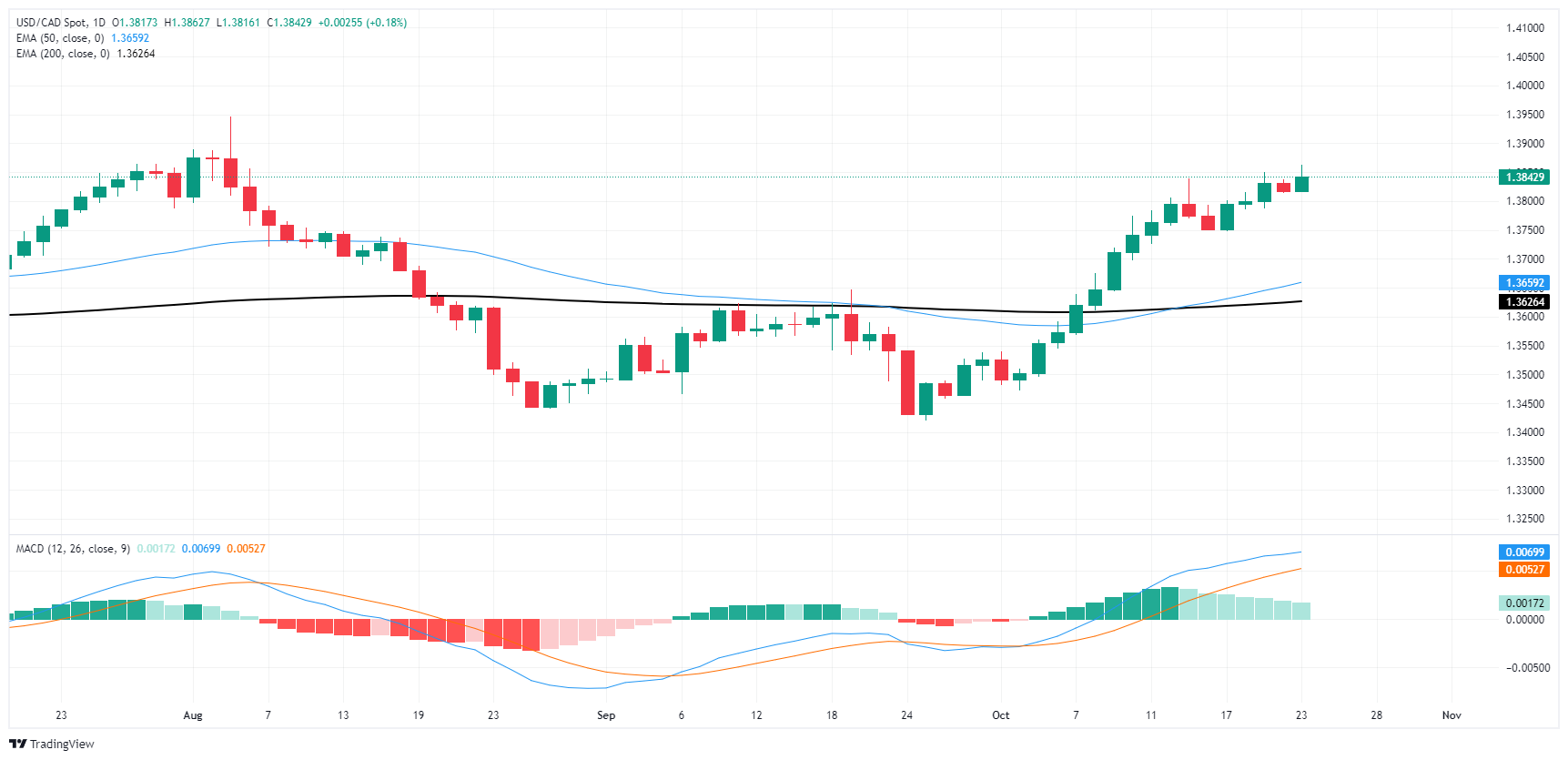Canadian Dollar explores further downside following BoC rate cut
- The Canadian Dollar shed a further fifth of a percent against the Greenback.
- The Bank of Canada delivered a widely-expected 50 bps rate trim on Wednesday.
- Rate markets see a decent chance of a further 50 bps BoC rate cut in December.
The Canadian Dollar (CAD) receded on Wednesday, backsliding another 0.2% against the US Dollar after the Bank of Canada (BoC) delivered a widely expected 50 bps rate cut. Rate traders are already pricing in a further double rate cut in December as the BoC grapples with Canada’s rapidly deflating economic landscape.
Canada continues to see the downside opening up in economic data prints, spurring the BoC to step up the pace of rate cuts heading into the end of the year. Canadian Retail Sales figures from August are slated to print on Friday, and are expected to stick to the trend and moderate further. However, the long-dated data is unlikely to spark much movement.
Daily digest market movers
- BoC cuts interest rates by 50 bps, meeting broad-market expectations.
- Canada’s main interest rate peaked at 5.0% in July 2023.
- Crumbling economic data and inflation prints have spurred the BoC to slash rates down to 3.75% overall.
- Rate swap markets see 25% odds of a follow-up 50 bps rate cut from the BoC in December.
- According to the BoC’s latest Monetary Policy Report, the Canadian central bank expects headline inflation figures to remain close to target levels for the foreseeably future despite delivering a total of five rate cuts through 2024.
Canadian Dollar price forecast
Momentum continues to drag the Canadian Dollar (CAD) lower, with the Loonie finding a fresh 11-week low against the Greenback on Wednesday. USD bulls are on pace to chalk in a fourth straight winning week against the CAD, and the USD/CAD chart is set to rechallenge the 1.3900 handle in the coming days.
It’s getting difficult for technical traders to ignore a long-run spiral baked into USD/CAD weekly candlesticks. The pair has ground out chart paper in a sideways channel since late 2022, with price action bouncing sharply between the 1.3900 and 1.3300 levels. Despite the Greenback’s recent hot streak against the Loonie, USD/CAD could be poised for a fresh tilt into the bearish side if bids can’t pierce into fresh multi-year highs above 1.4000 in the next few weeks.
USD/CAD daily chart
Canadian Dollar FAQs
The key factors driving the Canadian Dollar (CAD) are the level of interest rates set by the Bank of Canada (BoC), the price of Oil, Canada’s largest export, the health of its economy, inflation and the Trade Balance, which is the difference between the value of Canada’s exports versus its imports. Other factors include market sentiment – whether investors are taking on more risky assets (risk-on) or seeking safe-havens (risk-off) – with risk-on being CAD-positive. As its largest trading partner, the health of the US economy is also a key factor influencing the Canadian Dollar.
The Bank of Canada (BoC) has a significant influence on the Canadian Dollar by setting the level of interest rates that banks can lend to one another. This influences the level of interest rates for everyone. The main goal of the BoC is to maintain inflation at 1-3% by adjusting interest rates up or down. Relatively higher interest rates tend to be positive for the CAD. The Bank of Canada can also use quantitative easing and tightening to influence credit conditions, with the former CAD-negative and the latter CAD-positive.
The price of Oil is a key factor impacting the value of the Canadian Dollar. Petroleum is Canada’s biggest export, so Oil price tends to have an immediate impact on the CAD value. Generally, if Oil price rises CAD also goes up, as aggregate demand for the currency increases. The opposite is the case if the price of Oil falls. Higher Oil prices also tend to result in a greater likelihood of a positive Trade Balance, which is also supportive of the CAD.
While inflation had always traditionally been thought of as a negative factor for a currency since it lowers the value of money, the opposite has actually been the case in modern times with the relaxation of cross-border capital controls. Higher inflation tends to lead central banks to put up interest rates which attracts more capital inflows from global investors seeking a lucrative place to keep their money. This increases demand for the local currency, which in Canada’s case is the Canadian Dollar.
Macroeconomic data releases gauge the health of the economy and can have an impact on the Canadian Dollar. Indicators such as GDP, Manufacturing and Services PMIs, employment, and consumer sentiment surveys can all influence the direction of the CAD. A strong economy is good for the Canadian Dollar. Not only does it attract more foreign investment but it may encourage the Bank of Canada to put up interest rates, leading to a stronger currency. If economic data is weak, however, the CAD is likely to fall.
